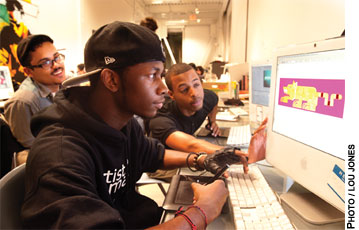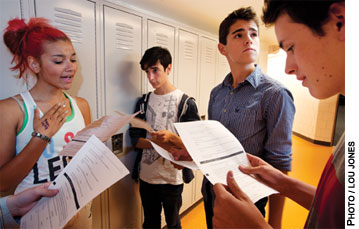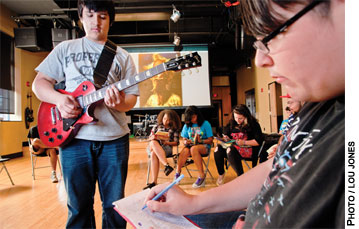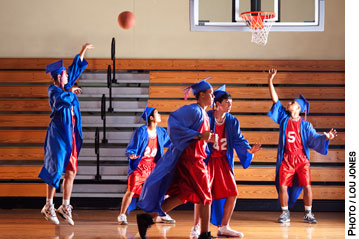Faced with a $30 million shortfall in its $295 million budget for the 2011–12 school year, the Adams 12 school district in north Denver laid off custodians, furloughed teachers, trimmed programs, reduced benefits—and then took its budget scalpel to student activities.
The district dropped middle-school sports, cut back on travel for its high-school teams, and pared $500,000 from the $2 million budget that supports afterschool activities like the Math Olympiad and spelling bee at Centennial Elementary, the technology and drama clubs at Rocky Top Middle School, and the anime (Japanese animation) and Knowledge Bowl clubs at Mountain Range High.
Christopher Gdowski, superintendent of the 42,000-student district, talks hopefully of volunteers stepping in to fill some of the gaps. The YMCA has approached him about taking over some of the sports teams, even offering to buy the used school uniforms and the licensing rights to the school mascots. But some activities may have trouble finding sponsors, he concedes, and teachers union contracts may preclude others from turning to the community for advisors.
“We’re hoping for the best, but we’re fearing the worst,” Gdowski told me.
With school districts struggling to keep their noses above choppy budget waters and voters howling about taxes, should schools really be funding ping-pong and trading-card clubs? Swim teams, swing dancing, moot court, powder-puff football? Latino unions, gay-straight alliances, the Future Business Leaders of America, the French Honors Society, the jazz band, the knitting club? The barbell club at Adams 12’s Niver Creek Middle School?
As it turns out, maybe they should. There’s not a straight line between the crochet club and the Ivy League. But a growing body of research says there is a link between afterschool activities and graduating from high school, going to college, and becoming a responsible citizen.
“Honestly, the place that best prepared me for college was the hardwood court of men’s varsity basketball” in high school, Andrew Snow, a University of Michigan senior and pre-law major, e-mailed me recently. “That court taught me hard work, sacrifice, teamwork, humility…and leadership,” he added, plus, “how to deal with people in social situations” and “responsibility off the court [because] if you made a bad decision, someone would see it.”

Cause or Effect?
The U.S. Department of Education last compiled data on extracurricular activities a decade ago, when it reported that more than half the country’s high-school sophomores participated in sports, that one-fifth were in a school-sponsored music group, and that cheerleading and drill teams, hobby, academic, and vocational clubs each involved about 10 percent of kids.
At affluent suburban schools, the choice of activities can be dizzying. Walt Whitman High School in Montgomery County, Maryland, a Washington, D.C., suburb, offered 89 clubs (equestrian, Persian, unicycle…), 26 sports, seven choral ensembles, seven bands or orchestras, a newspaper, a literary magazine, and a yearbook last year.
Whitman’s feeder school, Thomas W. Pyle Middle School, offered even more: 100 activities, including a stock market club, cooking, a math team, and a magic club.
Whitman says that 96 percent of its students go to college; its SAT scores in math and critical reading are 250 points above the national average. That isn’t because it has an equestrian team and a Shakespeare club, of course. The education department data show that kids from families in the top third by income and education are half again as likely to take part in sports and almost twice as likely to participate in music as kids from the bottom third. Almost 80 percent of the adults in Whitman’s zip code are college graduates, and the median household income is three times the U.S. average.
The data also show that kids with the highest test scores are the most active in afterschool activities. Two-thirds of kids in the top quarter of test takers played sports, for example, compared to less than half in the lowest quarter.
So, is there a link? Did kids who joined afterschool activities become good students, or did good students join afterschool activities?
As with a lot of social science research, the findings about extracurriculars aren’t always consistent or conclusive: You can’t randomly assign kids to soccer, after all. But some researchers insist there is a cause-effect relationship between activities and academic success, not just the other way around.
Margo Gardner, a research scientist at Columbia University’s National Center for Children and Families (NSCF), is among them—and certainly not alone. Using data from the 1988 National Education Longitudinal Study (NELS), and controlling for poverty, race, gender, test scores, and parental involvement, Gardner has calculated that the odds of attending college were 97 percent higher for youngsters who took part in school-sponsored activities for two years than for those who didn’t do any school activities.
The odds of completing college were 179 percent higher, and the odds of voting eight years after high school, a proxy for civic engagement, were 31 percent higher.
Gardner repeated the analysis using propensity-score matching, that is, comparing kids whose profiles suggested they had a similar propensity either to join or sit out afterschool activities. Even within those groups of similar kids, those who participated in activities had better school success rates than those who didn’t.
The National Center for Education Statistics, in its own analysis of the longitudinal or NELS data, found that high-school seniors who were involved in school activities were less likely to cut class and play hooky than kids who weren’t involved. Three times as many had a GPA of 3.0 or higher; twice as many scored in the top quarter on math and reading tests. And 68 percent expected to get a college degree, compared to 48 percent of kids who weren’t involved in school activities.
Other researchers have approached the question differently, but come up with complementary results. Angela Duckworth, a University of Pennsylvania psychologist, looked at college activities as a predictor of success. She rated the résumés of recent graduates who were applying for their first teaching jobs. She gave the highest scores to those people who had been in a college activity for several years, any college activity, and who had attained a level of leadership or achievement (say, MVP on the softball team).
Those with the highest “grit” scores, as she calls them—with the most persistence—turned out to be the best teachers, based on the academic gains of their students. As an added bonus, the “grittiest” scorers also were more likely to stay in their jobs rather than quit midyear.
Duckworth attributes the difference to perseverance rather than talent: There wasn’t any significant difference in teacher effectiveness based on the SAT scores and college GPAs of the job applicants, she calculated. This isn’t just about whether teachers are new, Duckworth told me: People who are persistent and passionate about something, whether cross-country or baton twirling or spelling bees, will carry over that enthusiasm to other parts of their lives.
Similarly, Betsey Stevenson, an assistant professor at the University of Pennsylvania’s Wharton School of business and currently the chief economist at the U.S. Department of Labor, has found a link between high-school sports and girls’ success. Stevenson compared the college-going and labor-force rates between girls who attended high school before the 1972 passage of Title IX and those who attended after. Title IX, an amendment to the Civil Rights Act of 1964, required high schools and colleges to offer girls and boys the same opportunities to play sports.
Again controlling for age, race, and their state of residence, Stevenson calculated that for every 10-percentage-point rise in the number of girls playing high-school sports in any state there was a 1-percentage-point increase in those going to college and a 1- to 2-point rise in those with jobs. Title IX led to a 30-percentage-point rise in girls’ sports participation, she adds.

Engaging Students
Temple University psychologist Laurence Steinberg, whose book, You and Your Adolescent: The Essential Guide for Ages 10–25, discusses afterschool activities. He suggested two more reasons for what he believes is a causal link between activities and academic success.
Kids who are involved in clubs and sports spend an extra couple of hours a week with an adult, usually a role model like a drama director or a football coach. “They don’t want to disappoint the coach,” Whitman’s principal, Alan S. Goodman, told me. All he has to do to straighten out a misbehaving athlete is to threaten to talk to the coach, he said: “‘Oh no, don’t talk to the coach,’ they tell me.”
Extracurriculars also make school more palatable for a whole lot of kids who otherwise find it bleak or unsatisfying, Steinberg said. Grades improve not because of what kids are learning in the video club, but because the video club is making them enjoy school more, so they show up more often, find a circle of like-minded friends, and become more engaged in school.
Christopher Gdowski, Adams 12’s superintendent, echoed Steinberg when I asked him what he meant by “fearing the worst” if some afterschool activities are canceled. His district polled thousands of taxpayers as part of its budget process: A huge majority opposed eliminating all activities, but most agreed on trimming the number of activities each school could offer.
Gdowski said he worries that for “some meaningful number of kids,” those activities are what brings them to school. “That’s the hook,” he said, and budget cuts could leave that hook unbaited.
Penny-wise?
After years of steady increases in education spending, and with the expiry of federal stimulus funds, school districts are facing some unaccustomed belt-tightening this year. K–12 spending rose 39 percent between the 1989–90 and the 2007–2008 school years, according to the U.S. Census bureau, and hit $605 billion in 2009, the latest year for which it has reported numbers.
But the National Business Officers Association has calculated that spending is expected to be off $2.5 billion this year from a year earlier. Florida’s 2012 budget cut K–12 spending by 8 percent, or about $540 a student. Arizona cut $183 million from K–12; New York cut more than $1 billion, and Colorado cut $250 million, according to the National Conference of State Legislatures.
The Center on Education Policy surveyed districts in the spring and found that 46 percent expect funding decreases of 5 percent or more in the 2011–12 school year (the poll asked districts about their “total funds available” for the year, excluding federal stimulus monies).
Staff salaries and benefits are taking much of the hit. But as bus routes, textbook purchases, and even cleaning supplies come under budget scrutiny, it’s no surprise that extracurriculars are in for some pain, too.
Diane M. Place, superintendent of the 1,700-student Towanda, Pennsylvania, school district, told me she received hate mail and “horrendous calls” when she recommended a $30-a-household tax increase to close a $2.2 million gap in her $24 million budget. Instead, she cut the instruction budget by 9 percent and then went after extracurriculars. She eliminated the rifle and junior robotics clubs, JV soccer, majorettes and one cheerleading squad, and halved the funding for the forensics team and Future Business Leaders.
The 1,000-student Salida, Colorado, school district, facing at least a $500,000 budget gap, moved to a four-day week, and then announced plans to cut Key Club, Math Counts, jazz, and weight lifting. Coos Bay, Oregon, planned to let go a Knowledge Bowl coach in the middle school and a forensics coach in high school after the district chopped $44,000 from its activities fund. Cincinnati is thinking of shifting all of its extracurriculars onto a community group, a move it predicted will save $250,000 a year, largely in teacher coaching stipends.

Or Pound-Foolish?
There’s no ready estimate of how much districts spend for extracurriculars: Districts account differently for teachers’ afterschool pay (it can be lumped in with merit pay, says Stephen Frank of Education Resource Strategies), whether they include team buses in the extracurricular budget, how much they depend on parents and booster clubs for field maintenance and stage-set construction, if and how much they charge students to participate, whether they use federal Title I funds for afterschool enrichment, and so on.
Marguerite Roza, who studies school finance at the University of Washington, calculates that districts spend about the same to suit up a youngster to play a sport as to enroll her in a semester of, say, history. A difference is that there are three seasons for sports, but two semesters for history.
Districts increasingly are depending on kids and their parents to fund extracurriculars. State laws, not national policy, determine which school expenses must be taxpayer-funded and which can be charged to students as user fees. California recently settled a lawsuit brought by the American Civil Liberties Union against dozens of Golden State schools that levied fees for classroom materials, lab fees, and afterschool activities.
But elsewhere, the Pennsylvania School Boards Association counts 33 states where at least some school districts charge athletes anywhere from $25 to $1,500. The band fee at Medina Senior High in Ohio is $200. Arlington, Massachusetts, public schools charge youngsters $405 to join the cheerleading squad and $480 to wrestle. Lakeville, Minnesota, charges $190 to join the debate team and $110 for the chess club.
Many of the best student-athletes, musicians, actors—even cheerleaders and debaters—already are paying lots more than that for private lessons. And some of the most talented spurn their school’s programs in favor of club soccer teams and community orchestras, arguments that budget cutters sometimes cite for trimming extracurriculars.
But Steinberg counters that no one suggests eliminating math classes for mediocre students, or depending on private tutors for calculus. “You could extend that argument out to its illogical extreme,” he said.
At Whitman High, where kids pay a $40 district-wide activities fee, Goodman told me he would rather increase class size than eliminate activities. “You can cope with an extra kid in your class, but at 2:10” when school lets out and intramural basketball is canceled, “what do they do?”
Police statistics offer one answer: Juvenile crime peaks between 3 p.m. and 6 p.m. Education department data offer another: 31 percent of high-school seniors watched three or more hours of television every weekday in 2004, the last time the department ran the numbers, up from 9 percent in 1992.

Lessons That Last
Tony Wagner, codirector of the Change Leadership Group at Harvard’s Graduate School of Education, told me he did a focus group a decade ago with college students who graduated from a leading public high school in New England. He asked them what “important things” they remembered about high school, three to five years after leaving.
“They described all their experiences in extracurricular activities and sports. This went on for an hour,” he said. But about what the remembered from their academics, “they said, ‘you basically start over.’”
The takeaway, Wagner said, is that extracurriculars “teach a lot of the skills you need as an adult: time management, leadership, self-discipline, and persistence for doing work that isn’t extrinsically motivated.” That dovetails with Wagner’s academic work, which defines the “skills of the future” as including adaptability, leading by influence, and initiative.
“Kids who have a significant involvement in an extracurricular activity have a capacity for focus, self-discipline, and time management that I see lacking in kids who just went through school focused on their GPA,” he told me. Like Gardner and Duckworth, he doesn’t single out football players over the engineering team, or vice versa. The kind of activities “seems not to matter; what matters is the level of engagement,” he said.
I tested Wagner’s conclusion using an updated version of the focus group: I posted a question on the Facebook pages of my college-going sons. I asked their friends what they learned in high school that best prepared them for college, and received answers that were carbon copies of Wagner’s.
No one dumped on high school—“It’s not that I didn’t have fine teachers,” Andrew Snow e-mailed me—but no one credited AP chemistry with preparing them for college, either. In fact, no one mentioned classes at all. Instead, they wrote that extracurriculars introduced them to new ideas and interests, taught them to study more efficiently, developed their social skills, and exposed them to caring adults. “Coach was a maker of honorable men,” wrote Snow.
Justine Mrosak, a first-year medical student at the University of Minnesota, wrote that high school taught her “how to balance my academics with other passions.” Basketball and choir took time, she wrote. “But I didn’t want to give up doing the things that I loved just to get good grades, so I really learned how to schedule my time, prioritize my activities, and make my studying [as] efficient as possible.”
Steven Zuckerman, a pre-law major at the University of Michigan, wrote that “the most valuable thing” he learned was “to challenge my inhibitions by trying new things.” That meant playing sports “I had never tried before,” joining clubs “about things that I never thought would interest me,” and, inevitably, meeting “people with whom I never saw myself connecting.” That curiosity has followed him into college, where he has worked on political campaigns, he says.
I’d rise to the defense of Algebra I any day, and I assume any social scientist would, too. But, leadership, adaptability, social skills? Try a couple years on the school newspaper to learn that.
June Kronholz, a contributing editor, spent four years on her high-school newspaper and 30 years at the Wall Street Journal.
This article appeared in the Winter 2012 issue of Education Next. Suggested citation format:
Kronholz, J. (2012). Academic Value of Non-Academics: The case for keeping extracurriculars. Education Next, 12(1), 8-14.



